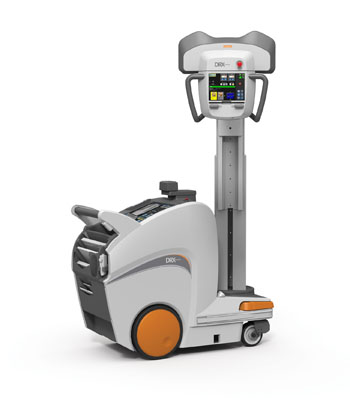Portable Digital Radiography Systems to Improve Access to Images
By MedImaging International staff writers
Posted on 26 Jul 2016
A U.S. hospital will deploy 11 mobile digital radiography systems to speed-up access to images and improve patient care in emergency rooms, Intensive Care Units (ICU) and operating theaters.Posted on 26 Jul 2016
The radiography systems will include advanced software features aimed at critical care, and will be used in the hospital’s emergency department, in two ICUs including one for neonatal care, and in operating rooms.

Image: The DRX-Revolution mobile digital x-ray system is designed to help hospitals image seriously ill and ER patients (Photo courtesy of Carestream Health).
Huntington Hospital (Pasadena, CA, USA) retrofitted DRX Plus 3543C detectors to two existing Carestream Health (Rochester, NY, USA) portable digital X-ray systems, and installed nine new Carestream DRX-Revolution mobile X-ray systems. For neonatal patients, the hospital purchased the small DRX 2530C detector. The hospital carries out more than 150,000 imaging exams every year. The two existing DRX-Revolution systems provide in excess of 2,300 exams every month in the emergency department of the hospital.
The Carestream DRX Plus is faster, lighter, has a thinner profile than previous versions, and features higher productivity, improved image quality, and a reduced radiation dose. The detectors are rated to IPX Level 7 for liquid resistance, and IEC standard 60529. Other features of the new detectors include faster calibration, boot, and preview times, and improved time-to-full-resolution display. The detectors have calibration file storage for a faster setup time, and improved battery life. The batteries can be changed without rebooting the system.
Ranilo Blasco, manager of Radiology, Huntington Hospital, said, “The DRX-Revolution systems deliver high-resolution images that can help our physicians quickly and accurately assess and treat acute care patients, as well as inpatients who require bedside exams. We standardized on these systems because of the platform’s innovative design and its ability to deliver excellent quality images as well as reliability and maneuverability. Physicians use these images to help position tubes and lines for seriously ill or injured patients and to detect pneumothorax. Because the companion image is created from the initial image, we do not need to capture multiple X-ray exams of these patients. Converting from CR to DR has not only improved image quality, it also has lowered the dose required to obtain an excellent image. This is especially important for our ICU and NICU patients, so we have installed cesium detectors in these areas to deliver the lowest dose possible while maintaining extremely high-quality imaging.”
Related Links:
Huntington Hospital
Carestream Health














